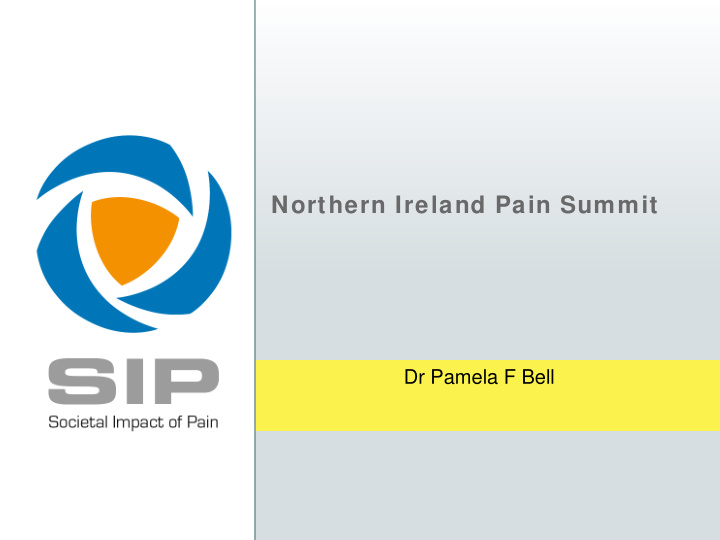



Northern Ireland Pain Summit Dr Pamela F Bell
Disclosure Statement of conflict of interest in the context of the subject of this presentation Within the past 12 months, I or my spouse/partner have had following financial interest/arrangement(s) or affiliation(s) below. Affiliation/Financial Relationship Company • Support for travel Napp Pharmaceuticals • Honoraria for lectures Pfizer Ltd • Honoraria for advisory board activities Grünenthal Ltd • Participation in clinical trials Grünenthal Ltd… • Research funding None • Financial shares and options None • …………………………….. ……………………
Northern Ireland • Population 1.75 million • Approx 0.7 million in Greater Belfast • 9% GDP from agriculture • Health and Social Care major employer • Service sector and tourism important • Heavy industry no longer important • Unemployment up to 20% adults • Higher prevalence of long term conditions cf. Great Britain • Highest prevalence of chronic pain in UK
Structure of Health and Social Care in Northern Ireland • Department of Health Social Services and Public Safety • Business Services Organisation • Regulation and Quality Improvement Authority • Public Health Agency • Health and Social Care Board • 5 Health and Social Care Trusts • 5 Local Commissioning Groups • 17 Primary Care Partnerships
2011
Pain Clinic Activity in Northern Ireland 2006 2011 2525 6412 new outpatients 6139 9765 review patients ???? 4273 day cases 5.0 10.7 wte pain clinicians 4 5 pain management programme centres
Background to the summit DHSS+PS Statement Chronic pain should be formally recognised as an entity in its own right. There is a need for a comprehensive and integrated service to facilitate a seamless system from primary care through hospital pain clinics to specialist interventions and back January 2005
Background to the summit • 3 major reorganisations of health and social care in NI since 2007 • 3 recent publications • Quality 2020 (2010) • Transforming your care (2011) • Policy framework: Living with long term conditions (2012) Transferring care for patients with chronic pain to community services and away from hospital based pain clinics
Who are the stakeholders? Patients their families and carers Voluntary sector organisations Staff of pain clinics Patient and Client Council Local Commissioners General practitioners and their staff Health and Social Care Board Public Health Agency Northern Ireland Assembly Department of Health Social Services and Public Safety Community organisations Employers Northern Ireland Pain Society British Pain Society Royal College of General Practitioners
How did we get stakeholders to buy in to the Summit? • Formed a reference group
Overarching aims and objectives of the NI Pain Summit • Raise awareness of the extent of the problem of people living with chronic pain • Raise awareness of the cost of chronic pain to the N Ireland Economy • Highlight to decision makers key opportunities to develop prevention strategies and services for people with chronic pain • Begin to develop consensus around the interventions and service models which offer the best strategies for people with chronic pain • Engage local organisations, leading providers and commissioners in these actions
How did we get stakeholders to buy in to the Summit? • Formed a reference group • Worked with the Patient and Client Council to develop a patient satisfaction survey • Met with Commissioner at HSC Board • Met with LCG Commissioners • Developed a key fact sheet and a road map for action
How did we get stakeholders to buy in to the Summit? • Formed a reference group • Worked with the Patient and Client Council to develop a patient satisfaction survey • Met with Commissioner at HSC Board • Met with LCG Commissioners • Developed a key fact sheet and a road map for action • Lobbied Members of the Legislative Assembly • Asked for a an informal appearance before the Health Committee of the NI assembly • Held a Pain Policy Event at Parliament Buildings
Did we forget anyone? • Mental Health and Addiction Services • Organisations dealing with victims of ‘The Troubles’ • High Street Pharmacists
On the day of the Summit • Meeting opened by the Minister for Health Social Services and Public Safety • Closed by the Chief Medical Officer • All stakeholders represented on the agenda • Overarching aims and objectives represented on the agenda • Workshops on education, public health and commissioning • Networking • Media coverage – medical, patient organisation, general
And the future? • Summit report to be written • Advice to the Minister, Health Committee and Chief Medical Officer • Outcomes from workshops to inform the work of educators, Public Health Agency and Commissioners • Carry out the patient satisfaction survey with the Patient and Client Council • Continue to engage with stakeholders • Key facts and road map for action already taken to the Pensioners’ Parliament by the Age Sector platform
Recommend
More recommend